Formation Mechanism and Petroleum Geological Significance of (Ferro) Dolomite Veins from Fractured Reservoirs in Granite Buried Hills: Insights from Qiongdongnan Basin, South China Sea
Abstract
1. Introduction
2. Geological Setting
3. Data and Methods
4. Results
4.1. Fracture Characteristics and Vein Composition
4.2. Lithological Characteristics of Dolomite Veins and Filling Stages
4.3. Geochemical Characteristics of (Ferro) Dolomite Veins
5. Discussions
5.1. Tectonic Activity and Fracture Formation
5.2. Formation Mechanism of (Ferro) Dolomite Veins
5.3. Petroleum Geological Significance
6. Conclusions
Supplementary Materials
Author Contributions
Funding
Institutional Review Board Statement
Informed Consent Statement
Data Availability Statement
Conflicts of Interest
References
- McGlade, C.; Speirs, J.; Sorrell, S. Unconventional gas: A review of regional and global resource estimates. Energy 2013, 55, 571–584. [Google Scholar] [CrossRef]
- Zeng, F.; Dong, C.; Lin, C.; Tian, S.; Wu, Y.; Lin, J.; Liu, B.; Zhang, X. Pore structure characteristics of reservoirs of Xihu Sag in East China Sea Shelf Basin based on dual resolution X-ray computed tomography and their influence on permeability. Energy 2022, 239, 122386. [Google Scholar] [CrossRef]
- Trinh, X.C.; Warren, J.K. Bach Ho field, a fractured granitic basement reservoir, Cuulong Basin, offshore SE Vietnam: A “buried-hill” play. J. Pet. Geol. 2009, 32, 129–156. [Google Scholar] [CrossRef]
- Qu, X.J.; Zhu, C.B.; Chen, X.J.; Chen, P.; Tan, B.; Xiong, Y.X.; Guo, S.S.; Jiang, N. Reservoir interpretation of intrusive rock buried-hill with mud-logging data while drilling—Taking the Y Area in the Qiongdongnan Basin of the South China Sea as an example. Energies 2022, 15, 3813. [Google Scholar] [CrossRef]
- Landes, K.K.; Amoruso, J.J.; Charlesworth, L.J. Petroleum resources in basement rocks. AAPG Bull. 1960, 44, 1682–1691. [Google Scholar] [CrossRef]
- Dewandel, B.; Lachassagne, P.; Krishnamurthy, N.S. A generalized 3-D geological and hydrogeological conceptual model of granite aquifers controlled by single or multiphase weathering. J. Hydrol. 2006, 330, 260–284. [Google Scholar] [CrossRef]
- Plotnikova, I. Nonconventional hydrocarbon targets in the crystalline basement, and problem of recent replenishment of hydrocarbon reserves. J. Geochem. Explor. 2006, 89, 335–338. [Google Scholar] [CrossRef]
- Dou, L.R.; Wang, J.C.; Wei, R.C. Precambrian basement reservoirs: Case study from northern Bonger Basin, the Republic of Chad. AAPG Bull. 2018, 102, 1803–1824. [Google Scholar] [CrossRef]
- Ye, T.; Wei, A.; Sun, Z. The reservoir characteristics and their significance for deliverability in metamorphic granite buried hill: A case study from the JZS oil field in the Liaodong Bay Basin, NE China. Arab. J. Geosci. 2019, 12, 630. [Google Scholar] [CrossRef]
- You, L.; Xu, S.L.; Mao, X.L.; Zhong, J.; Jiao, Y.Q.; Xiong, X.F. Reservoir characteristics and genetic mechanisms of the Mesozoic granite buried hills in the deep-water of the Qiongdongnan Basin, northern South China Sea. Acta Geol. Sin.-Engl. Ed. 2021, 95, 259–267. [Google Scholar] [CrossRef]
- Shi, H.S.; Yang, J.; Zhang, Y. Geological understanding innovation and major breakthrough to natural gas exploration in deep water in Qiongdongnan Basin. China Pet. Explor. 2019, 24, 691–698, (In Chinese with English Abstract). [Google Scholar] [CrossRef]
- Ji, M.; Zeng, Q.B.; Yang, H.Z.; Guo, S.; Zhong, K. Structural characteristics of central depression belt in deep-water area of the Qiongdongnan Basin and the hydrocarbon discovery of Songnan low bulge. Acta Oceanol. Sin. 2021, 40, 42–53. [Google Scholar] [CrossRef]
- Zhang, Y.; Zhang, L.; Zhou, J.; Zhu, J.T.; Tang, L.S.; Zhou, Y.Z. Multifractal properties of oil and gas indices in the Songnan Low Uplift of the Qiongdongnan Basin deepwater area. Geochem. Explor. Environ. Anal. 2022, 22, 2021–2092. [Google Scholar] [CrossRef]
- Zhou, J.; Yang, X.; Yang, J.; Wu, H.; He, X.; Song, A. Development characteristics and formation mechanism of Mesozoic buried hill fractures in the deep water area of Qiongdongnan Basin: Taking Y8 area in Songnan low uplift as an example. China Offshore Oil Gas 2020, 32, 1–9, (In Chinese with English Abstract). [Google Scholar] [CrossRef]
- Li, S.; Hu, L.; Gan, J.; Wu, Q.; Li, X.; Li, M.; Chen, K.; Li, F.; Zheng, F. Accumulation conditions of buried-hill hydrocarbon reservoirs on the Lingnan low uplift in the deep water areas of Qiongdongnan Basin. Mar. Geol. Front. 2021, 37, 68–75, (In Chinese with English Abstract). [Google Scholar] [CrossRef]
- Luan, G.; Dong, C.; Azmy, K.; Lin, C.; Ma, C.; Ren, L.; Zhu, Z. Origin of bedding-parallel fibrous calcite veins in lacustrine black shale: A case study from Dongying Depression, Bohai Bay Basin. Mar. Pet. Geol. 2019, 102, 873–885. [Google Scholar] [CrossRef]
- Tariq, W.; Gardezi, S.A.H.R.; Ikram, N. Impact of fractures and diagenesis on reservoir potential of inner ramp Paleocene carbonates exposed in western part of the Lesser Himalayas of Pakistan. J. Earth Sci. 2023, 34, 536–555. [Google Scholar] [CrossRef]
- Yousef, I.; Morozov, V.; Sudakov, V.; Idrisov, I. Microfracture characterization in sandstone reservoirs: A case study from the Upper Triassic of Syria’s Euphrates Graben. J. Earth Sci. 2023, 34, 901–915. [Google Scholar] [CrossRef]
- Sun, L.; Sun, Z.; Zhang, Y.; Zhao, Z.; Zhao, J.; Zhang, C.; Zhang, Z.; Sun, L.; Zhu, X. Multi-stage carbonate veins at IODP Site U1504 document Early Cretaceous to early Cenozoic extensional events on the South China Sea margin. Mar. Geol. 2021, 442, 106656. [Google Scholar] [CrossRef]
- Roberts, N.M.W.; Rasbury, E.T.; Parrish, R.R.; Smith, C.J.; Horstwood, M.S.A.; Condon, D.J. A calcite reference material for LA-ICP-MS U-Pb geochronology. Geochem. Geophys. Geosyst. 2017, 18, 2807–2814. [Google Scholar] [CrossRef]
- Dix, G.R.; Davis, D.W.; Chadirji-Martinez, K.; Marshall, D.D.; Kendrick, J.L.; Yakymchuk, C.; Sutcliffe, C.N. Hydrochemical impact of a mantle plume recorded by petrology, geochemistry, and U-Pb geochronology of a calcite vein within the Ottawa-Bonnechere graben, Ontario, Canada. Chem. Geol. 2021, 586, 120582. [Google Scholar] [CrossRef]
- Wu, A.; Cao, J.; Zhang, J. Bedding-parallel calcite veins indicate hydrocarbon–water–rock interactions in the over-mature Longmaxi shales, Sichuan Basin. Mar. Pet. Geol. 2021, 133, 105303. [Google Scholar] [CrossRef]
- Gan, J.; Ji, H.; Liang, G.; He, X.; Xiong, X.; Li, X. Gas accumulation model of Mesozoic buried hill in Qiongdongnan Basin. Geoscience 2022, 36, 1242–1253, (In Chinese with English Abstract). [Google Scholar] [CrossRef]
- Tang, L.; Fan, C.; Zhang, Y.; Xiong, X.; Duan, L.; Zhu, J. Tectonic evolution of granite buried hill and its control on reservoir accumulation in Qiong-dongnan Basin. Mar. Geol. Front. 2022, 39, 81–90, (In Chinese with English Abstract). [Google Scholar] [CrossRef]
- Guo, Y.; Guo, J.; Li, Z.; Yu, H.; Huang, Y. Geological model of weathering crust of granite buried hill in YLA area of Southeastern Hainan Basin. J. Cent. South Univ. (Sci. Technol.) 2022, 53, 3462–3473, (In Chinese with English Abstract). [Google Scholar] [CrossRef]
- Duan, W.; Li, C.F.; Luo, C.F.; Chen, J.D.; Huang, X.S.; Yan, Z.Y. Formation of an anomalously high-porosity zone of a very fine-grained deep clastic reservoir in the Qiongdongnan Basin, South China Sea. Geol. J. 2020, 55, 8244–8263. [Google Scholar] [CrossRef]
- Ren, J.F.; Cheng, C.; Xiong, P.F.; Kuang, Z.G.; Liang, J.Q.; Lai, H.F.; Chen, Z.G.; Chen, Y.; Li, T.; Jiang, T. Sand-rich gas hydrate and shallow gas systems in the Qiongdongnan Basin, northern South China Sea. J. Pet. Sci. Eng. 2022, 215, 110630. [Google Scholar] [CrossRef]
- Li, Y.F.; Pu, R.H.; Zhang, G.C.; Du, J.M.; Bao, J.J. New-type pliocene channel depositional systems resulting from turbidity flows obliquely interacting with contour currents: A novel case study from the southern Qiongdongnan Basin, northern South China Sea. Mar. Pet. Geol. 2023, 147, 105982. [Google Scholar] [CrossRef]
- Xu, C.G.; Li, Y. North slope transition zone of Songnan-Baodao sag in Qiongdongnan Basin and its control on medium and large gas fields, South China Sea. Pet. Explor. Dev. 2022, 49, 1229–1242. [Google Scholar] [CrossRef]
- Liu, M.N.; Liu, H.; Van Loon, A.J.; Xu, J.; Hao, S.M.; Zhang, Y.Z. Analysis of the geometric characteristics of clinothems and the relationship with shelf-edge trajectories of the Plio-Pleistocene continental slope in the Qiongdongnan Basin, South China Sea. Sedimentology 2023, 70, 5–30. [Google Scholar] [CrossRef]
- Zuo, X.; Wang, T.; Shi, L.; Lei, L.; Wu, J.; Dou, L.; Li, T. Study on the solid production mechanism of the fractured granite reservoirs: Example of YL area in Qiongdongnan Basin. Processes 2022, 10, 2556. [Google Scholar] [CrossRef]
- Mi, L.J.; Yang, H.Z.; Yang, S.C.; Guo, S. Zircon U-Pb geochronology, Hf isotopes, and geochemistry constraints on the age and tectonic affinity of the basement granitoids from the Qiongdongnan Basin, northern South China Sea. Acta Oceanol. Sin. 2023, 42, 19–30. [Google Scholar] [CrossRef]
- Liu, Y.S.; Hu, Z.C.; Gao, S.; Guenther, D.; Xu, J.; Gao, C.G.; Chen, H.H. In situ analysis of major and trace elements of anhydrous minerals by LA-ICP-MS without applying an internal standard. Chem. Geol. 2008, 257, 34–43. [Google Scholar] [CrossRef]
- Al-Aasm, I.S.; Taylor, B.E.; South, B.E. Stable isotope analysis of multiple carbonate samples using selective acid extraction. Chem. Geol. (Isot. Geosci.) 1990, 80, 119–125. [Google Scholar] [CrossRef]
- Coplen, T.B.; Kendall, C.; Hopple, J. Comparison of stable isotope reference samples. Nature 1983, 302, 236–238. [Google Scholar] [CrossRef]
- Masuda, A.; Nakamura, N.; Tanaka, T. Fine structures of mutually normalized rare-earth patterns of chondrites. Geochim. Cosmochim. Acta 1973, 37, 239–248. [Google Scholar] [CrossRef]
- Wang, Y.Y.; Zhao, Y.H.; Ding, W.W.; Fang, P.G.; Li, J.B. Cenozoic Propagated Rifting in the Dangerous Grounds in Response to the Episodic Seafloor Spreading of the South China Sea. J. Earth Sci. 2022, 33, 1031–1046. [Google Scholar] [CrossRef]
- Zhou, J.; Yang, X.; Yang, J.; Gan, J.; Wu, H.; He, X.; Hu, B. Structure sedimentary evolution and gas accumulation of Paleogene in Songnan Low Uplift of the Qiongdongnan Basin. Earth Sci. 2019, 44, 2704–2716, (In Chinese with English Abstract). [Google Scholar] [CrossRef]
- Chen, J.J.; Ma, Y.P.; Chen, J.Z.; Sun, G.B. Tectonic dynamics of northern continental margin basins in South China Sea. Earth Sci. Front. 2015, 22, 038–047, (In Chinese with English Abstract). [Google Scholar] [CrossRef]
- Zhao, Z.; Sun, Z.; Sun, L.; Wang, Z.; Sun, Z. Cenozoic tectonic subsidence in the Qiongdongnan Basin, northern South China Sea. Basin Res. 2018, 30 (Suppl. 1), 269–288. [Google Scholar] [CrossRef]
- Al-Aasm, I.S.; Muir, I.; Morad, S. Diagenetic conditions of fibrous calcite vein formation in black shales: Petrographic and chemical evidence. Can. J. Pet. Geol. 1993, 41, 46–56. [Google Scholar] [CrossRef]
- Xia, L.; Cao, Y.; Bian, B.; Liu, H.; Wang, X.; Zhao, Y.; Yan, M. Genesis of calcite vein in basalt and its effect on reservoir quality: A case study of the Carboniferous in the east slope of Mahu sag, Junggar Basin, NW China. Pet. Explor. Dev. 2021, 48, 864–876. [Google Scholar] [CrossRef]
- Jin, Z.; Cao, J.; Hu, W.; Zhang, Y.; Yao, S.; Wang, X.; Zhang, Y.; Tang, Y.; Shi, X. Episodic petroleum fluid migration in fault zones of the northwestern Junggar Basin (northwest China): Evidence from hydrocarbon-bearing zoned calcite cement. AAPG Bull. 2008, 92, 1225–1243. [Google Scholar] [CrossRef]
- Hu, W.; Chen, Q.; Wang, X. REE models for the discrimination of fluids in the formation and evolution of dolomite reservoirs. Oil Gas Geol. 2010, 31, 810–818, (In Chinese with English Abstract). [Google Scholar]
- Guo, C.; Song, H.; Liang, J. Origin of Cambrian dolomite from well Milan1 in Tadong area and its significance to dolomite reservoirs. Oil Gas Geol. 2020, 41, 953–964, (In Chinese with English Abstract). [Google Scholar] [CrossRef]
- Li, R.; Duan, J.; Pan, L.; Li, H. Genetic mechanism and main controlling factors of the Middle Permian Maokou Formation dolomite reservoirs in the eastern Sichuan Basin. Nat. Gas Geosci. 2021, 32, 1347–1357, (In Chinese with English Abstract). [Google Scholar] [CrossRef]
- Toyoda, K.; Horiuchi, H.; Tokonami, M. Dupal anomaly of Brazilian carbonatites: Geochemical correlations with hotspots in the South Atlantic and implications for the mantle source. Earth Planet. Sci. Lett. 1994, 126, 315–331. [Google Scholar] [CrossRef]
- Schmid, S.; Worden, R.; Fisher, Q. Diagenesis and reservoir quality of the Sherwood Sandstone (Triassic), Corrib Field, Slyne Basin, west of Ireland. Mar. Pet. Geol. 2004, 21, 299–315. [Google Scholar] [CrossRef]
- Xi, K.; Cao, Y.; Lin, M. Applications of light stable isotopes (C, O, H) in the study of sandston diagenesis: A review. Acta Geol. Sin. 2019, 93, 213–226. [Google Scholar] [CrossRef]
- Hudson, J.D. Stable isotopes and limestone lithification. J. Geol. Soc. 1977, 133, 637–660. [Google Scholar] [CrossRef]
- Prosser, D.J.; Daws, J.A.; Fallick, A.E. Geochemistry and diagenesis of stratabound calcite cement layers within the Rannoch Formation of Brent Group, Murchison Field, North Viking Graben (North North Sea). Sediment. Geol. 1993, 87, 139–164. [Google Scholar] [CrossRef]
- Al-Aasm, I.S.; Coniglio, M.; Desrochers, A. Formation of complex fibrous calcite veins in Upper Triassic strata of Wrangellia Terrain, British Columbia, Canada. Sediment. Geol. 1995, 100, 83–95. [Google Scholar] [CrossRef]
- Sass, E.; Bein, A.; Labin, A.A. Oxygen isotope composition of diagenetic calcite in organic-rich rocks: Evidence for 18O depletion in marine anaerobic pore water. Geology 1991, 19, 839–842. [Google Scholar] [CrossRef]
- Land, L.S. The application of stable isotopes to studies of the origin of dolomite and to problems of diagenesis of clastic sediments. Stable isotopes in sedimentary geology. SEPM Short Course 1983, 10, 4.1–4.22. [Google Scholar]
- Friedman, I.; O’Neil, J.R. Compilation of Stable Isotope Fractionation Factors of Geochemical Interest US Geological Survey Professional Paper (440−KK); US Geological Survey: Reston, VA, USA, 1977; p. 12. [Google Scholar]
- Jiang, L.; Cai, C.; Worden, R.H.; Crowley, S.F.; Jia, L.Q.; Zhang, K.; Duncan, I.J. Multiphase dolomitization of deeply buried Cambrian petroleum reservoirs, Tarim Basin, north-west China. Sedimentology 2016, 63, 2130–2157. [Google Scholar] [CrossRef]
- Liu, S.B.; Huang, S.J.; Shen, Z.M.; Lv, Z.X.; Song, R.C. Diagenetic fluid evolution and water-rock interaction model of carbonate cements in sandstone: An example from the reservoir sandstone of the Fourth Member of the Xujiahe Formation of the Xiaoquan-Fenggu area, Sichuan Province, China. Sci. China Earth Sci. 2014, 57, 1077–1092. [Google Scholar] [CrossRef]
- Hayes, M.J.; Boles, J.R. Evidence for meteoric recharge in the San Joaquin Basin, California, provided by isotope and trace element geochemistry. Mar. Pet. Geol. 1993, 10, 135–144. [Google Scholar] [CrossRef]
- Boles, J.R.; Eichhubl, P.; Garven, G. Evolution of a hydrocarbon migration pathway along basin-bounding faults: Evidence from fault cement. AAPG Bull. 2004, 88, 947–970. [Google Scholar] [CrossRef]
- Packard, J.; Al-Aasm, I.S.; Samson, I. A devonian “hydrothermal” chert reservoir: The 225 Bcf Parkland Field, British Columbia, Canada. AAPG Bull. 2001, 85, 51–84. [Google Scholar] [CrossRef]
- Klinkhammer, G.P.; Elderfield, H.; Mitra, A. Geochemical implications of rare earth element patterns in hydrothermal fluids from mid-ocean ridges. Geochim. Cosmochim. Acta 1994, 58, 5105–5113. [Google Scholar] [CrossRef]
- McArthur, J.M.; Burnett, J.; Hancock, J.M. Strontium isotopes at K/T boundary. Nature 1992, 355, 28. [Google Scholar] [CrossRef]
- Faure, G.; Powell, J.L. Strontium Isotope Geology. In Minerals, Rocks and Mountains; Springer: Berlin/Heidelberg, Germany, 2012. [Google Scholar] [CrossRef]
- Palmer, M.R.; Edmond, J.M. The strontium isotope budget of the modern ocean. Earth Planet. Sci. Lett. 1989, 92, 11–26. [Google Scholar] [CrossRef]
- Palmer, M.R.; Elderfield, H. Sr isotope composition of sea-water over the past 75 Myr. Nature 1985, 314, 526–528. [Google Scholar] [CrossRef]
- Hu, W.; Jin, Z.; Zhang, Y. Mineralogy and geochemical records of episodic reservoiring of hydrocarbon: Example from the reservoirs in the northwest margin of Junggar Basin. Oil Gas Geol. 2006, 27, 442–450, (In Chinese with English Abstract). [Google Scholar]
- Song, A.; Yang, J.; Hu, B.; Liu, Y.; Ren, L.; Cao, J. Distribution patterns of fracture reservoirs in the buried hills in deep water areas of Qiongdongnan Basin and prediction of favorable areas for hydrocarbon exploration. Mar. Geol. Front. 2021, 37, 60–67, (In Chinese with English Abstract). [Google Scholar] [CrossRef]
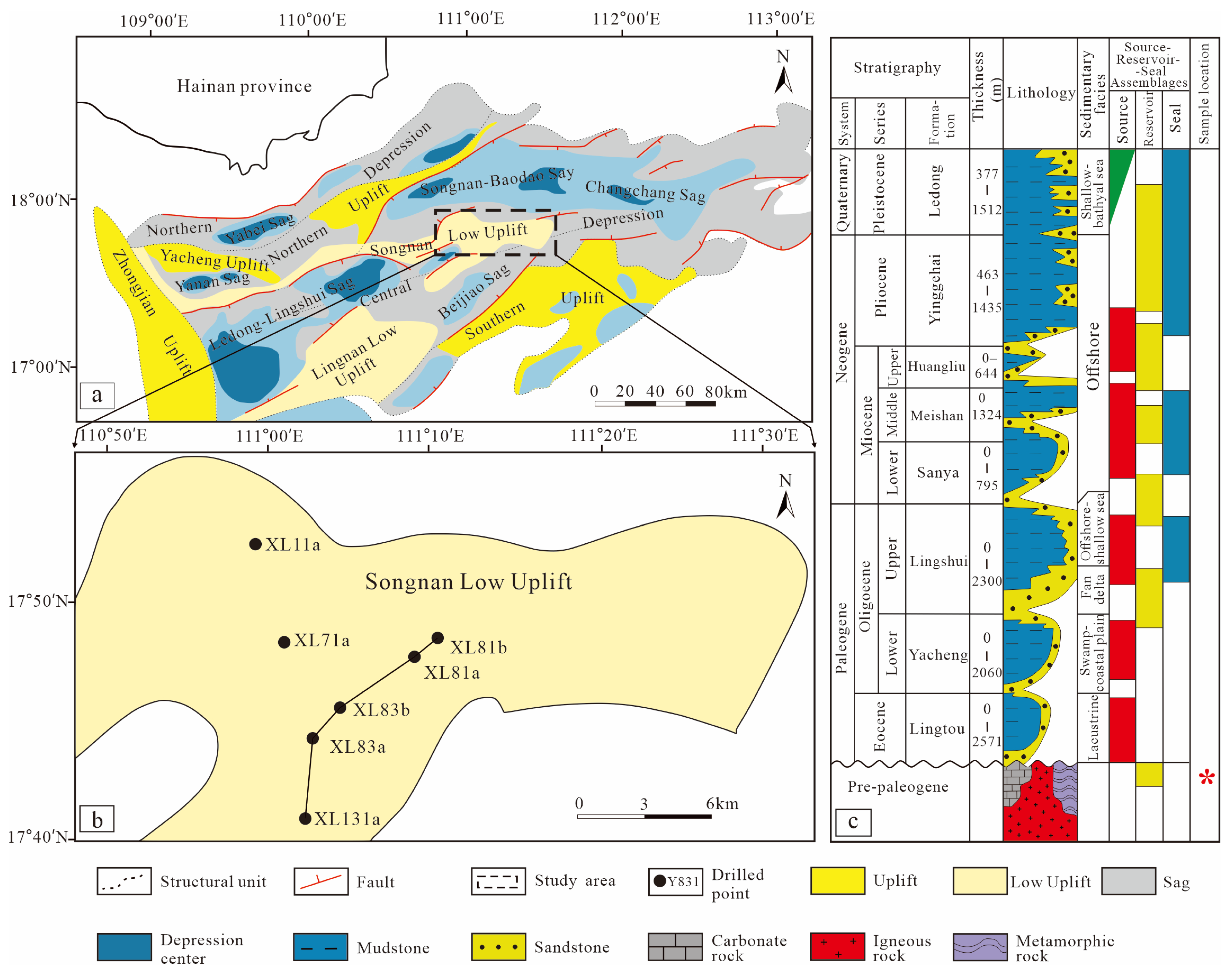
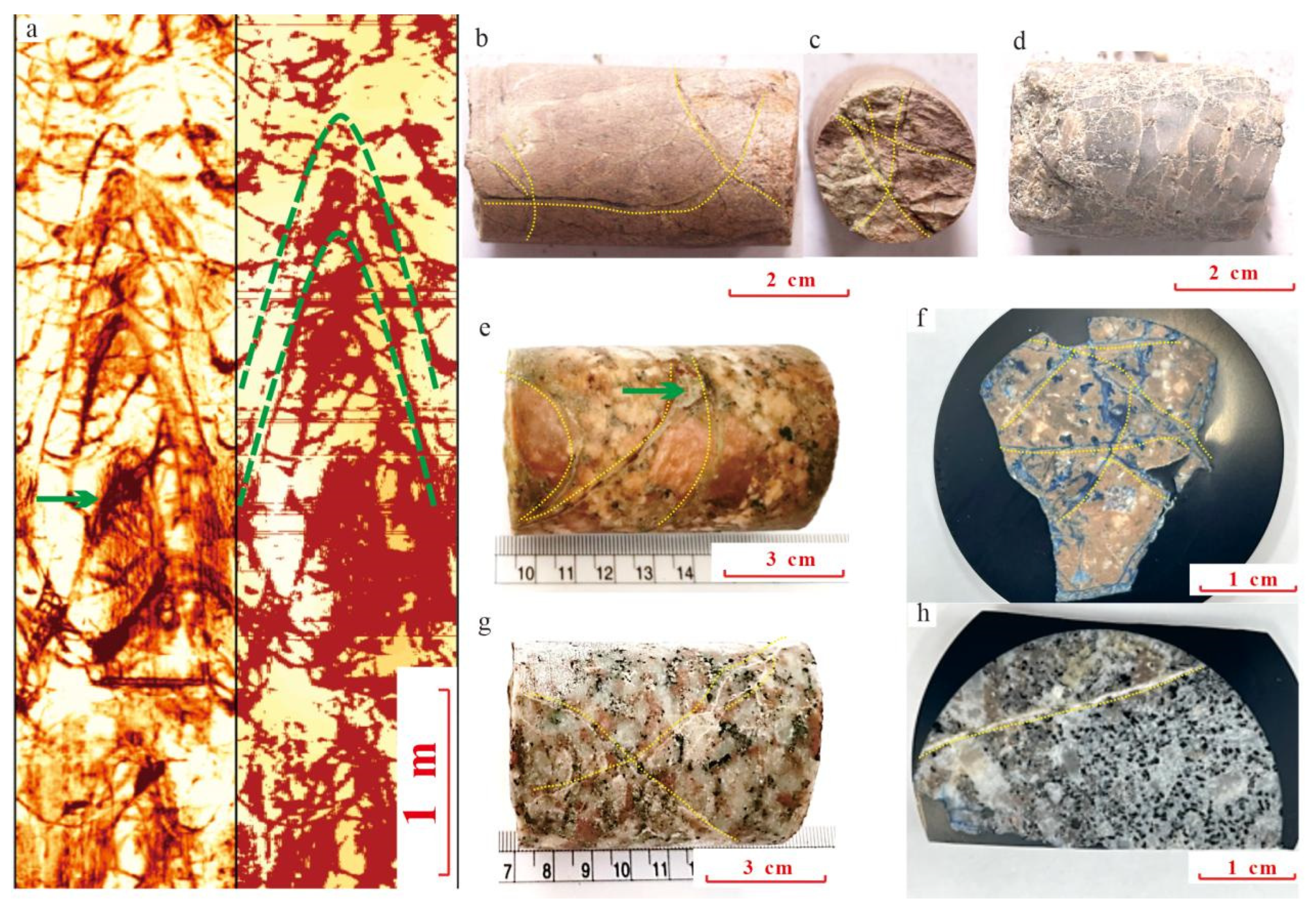
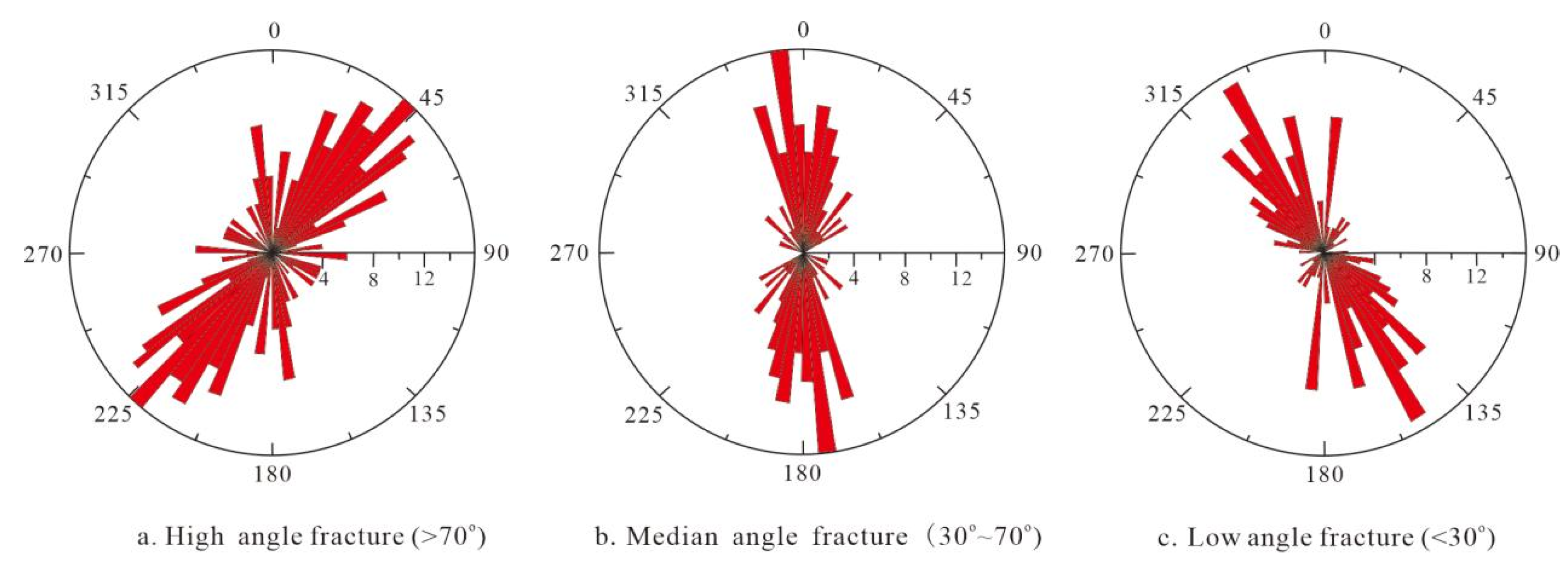


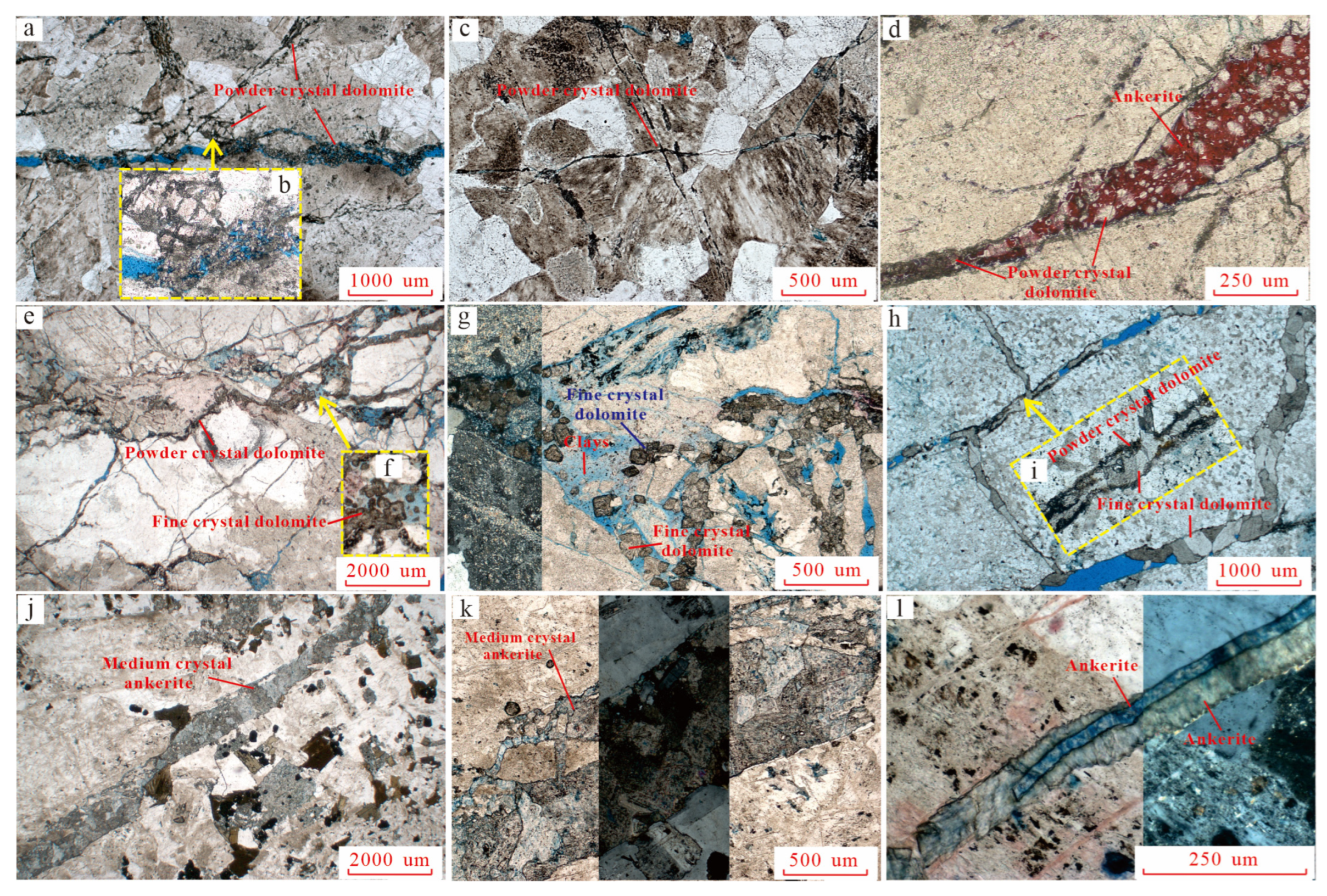
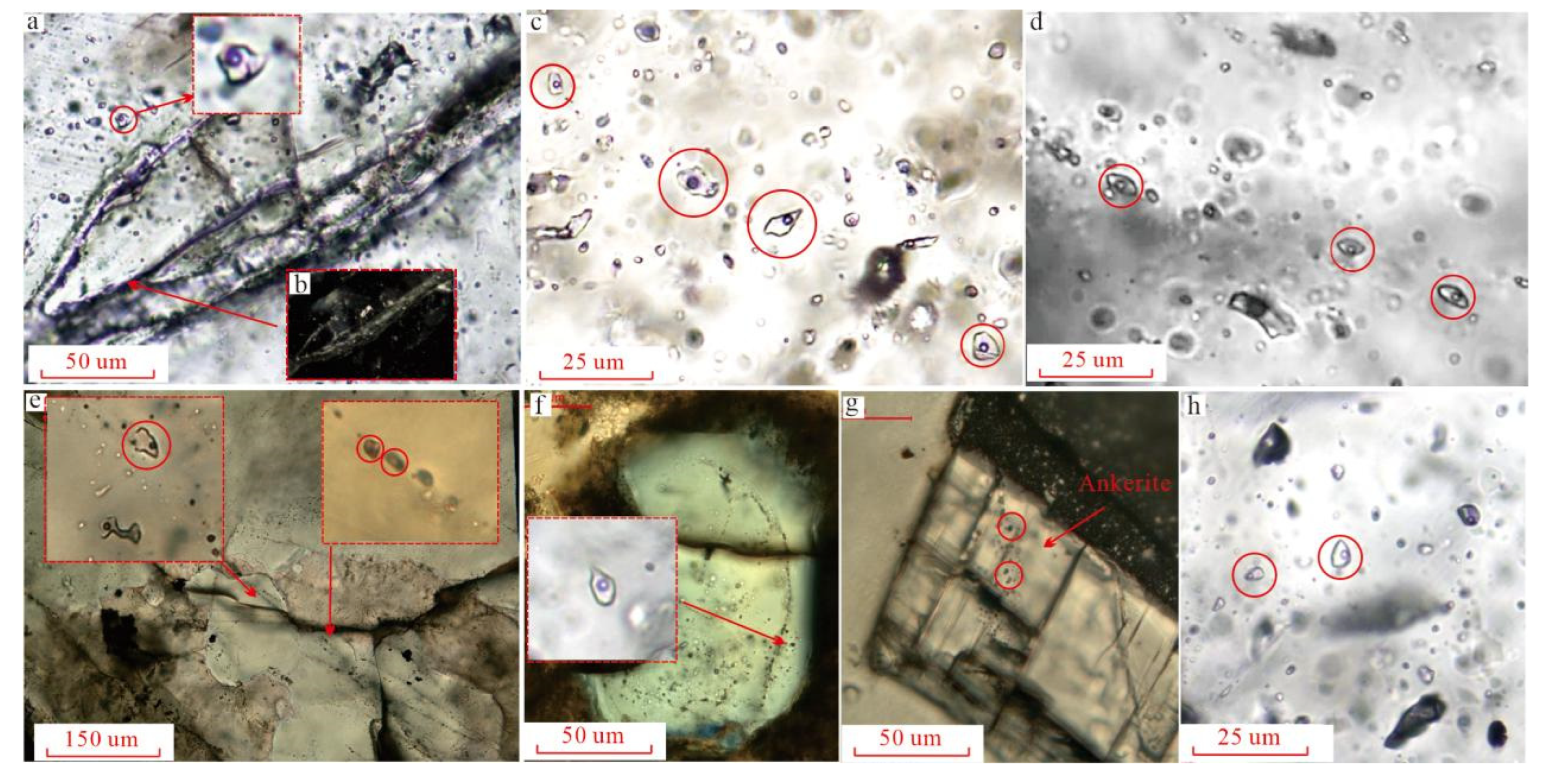
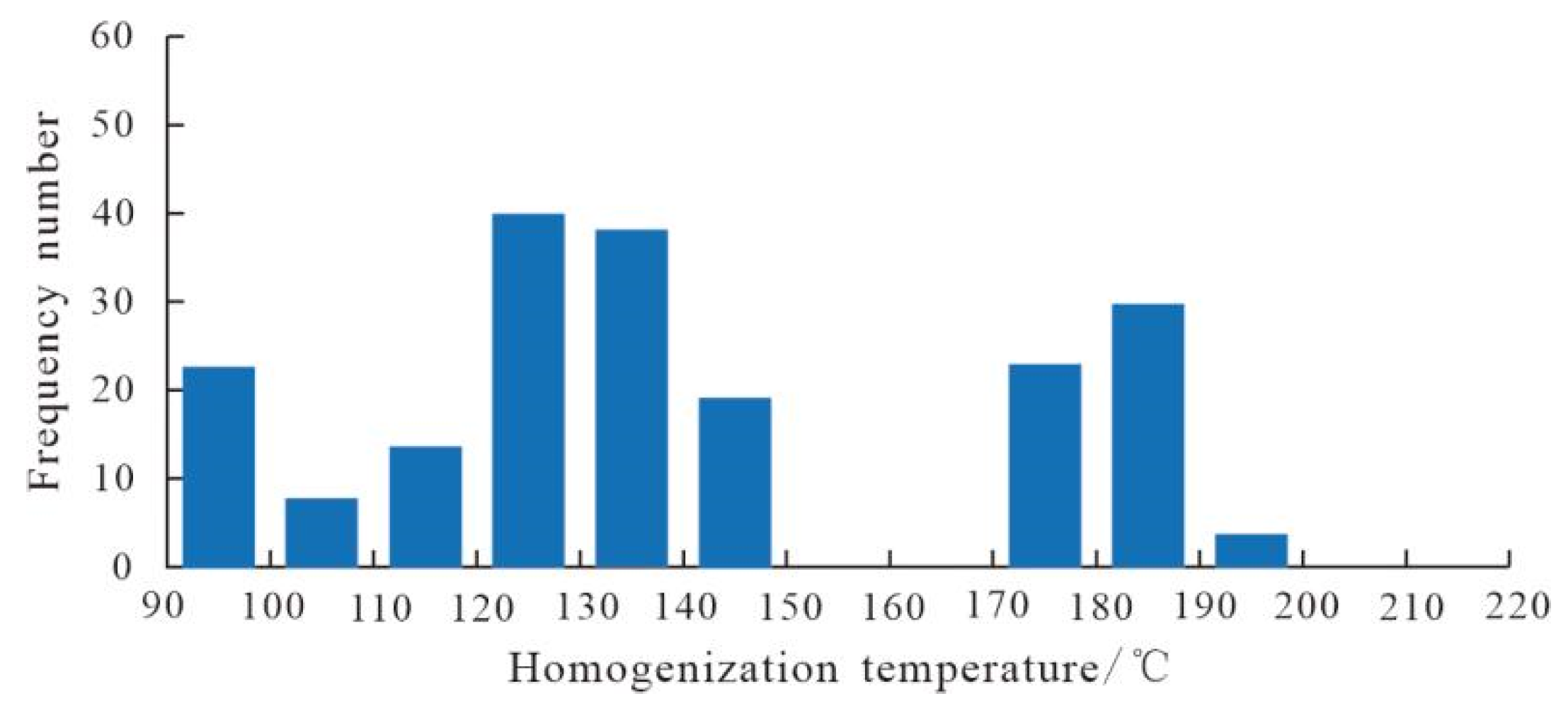
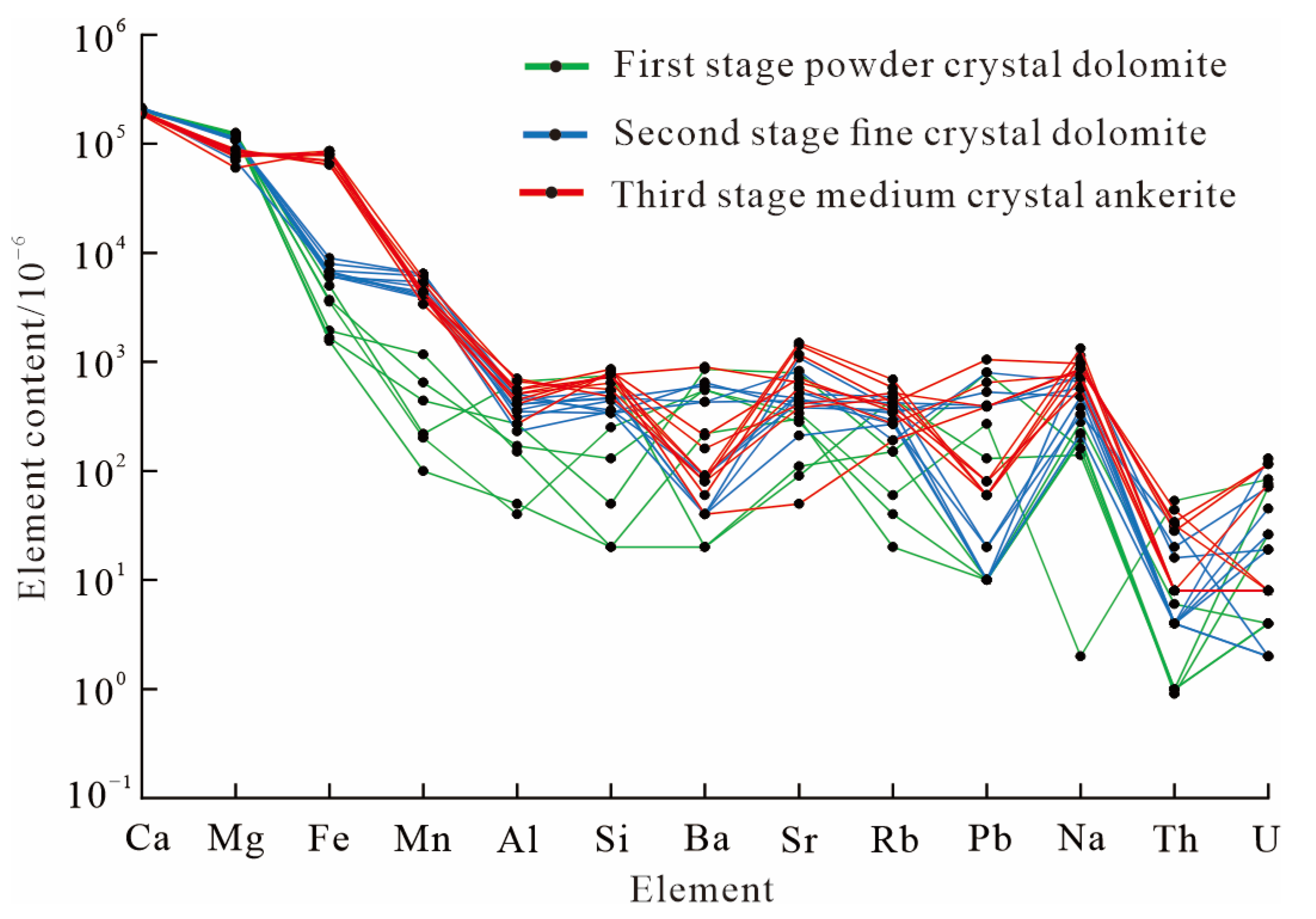


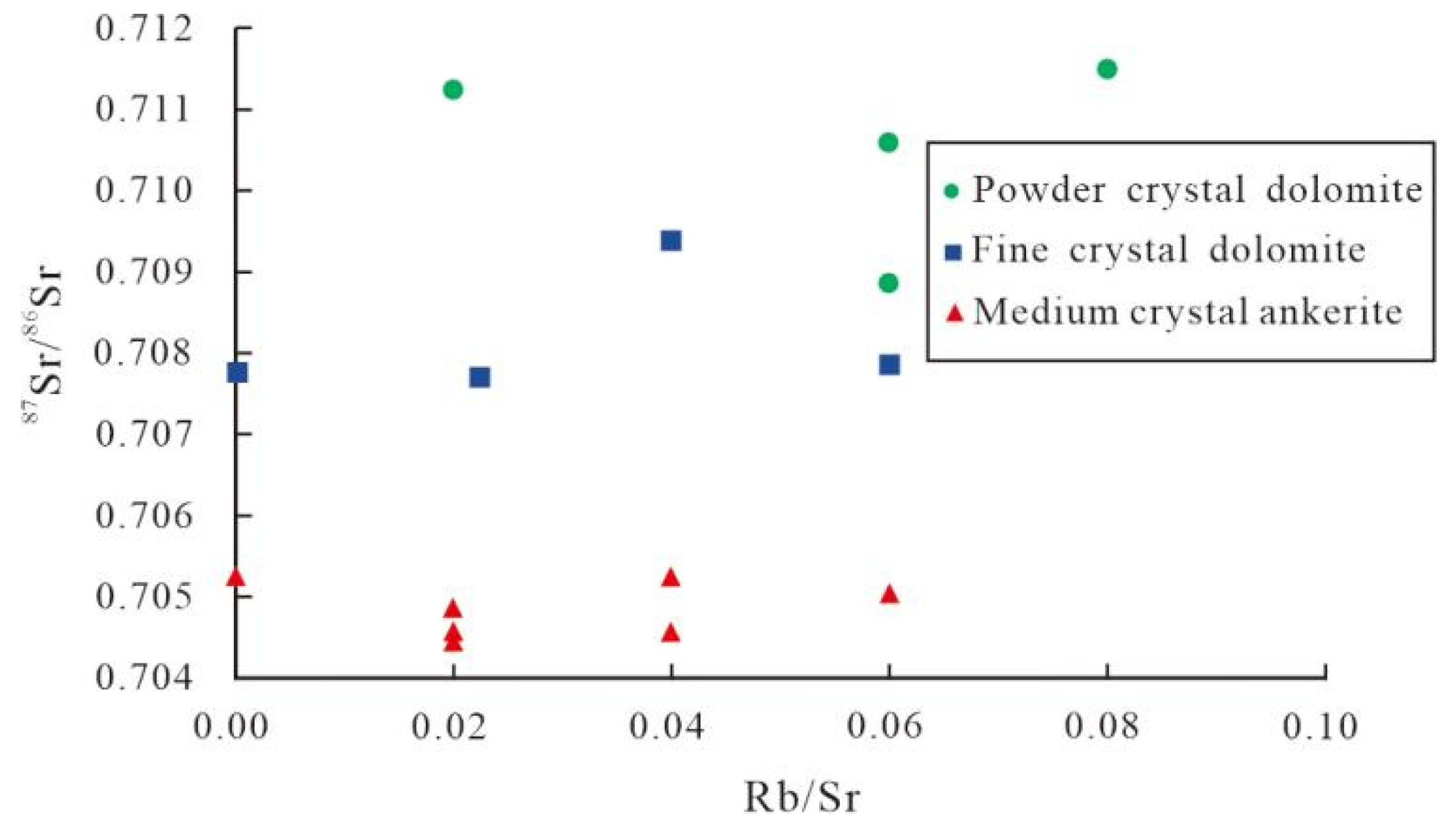

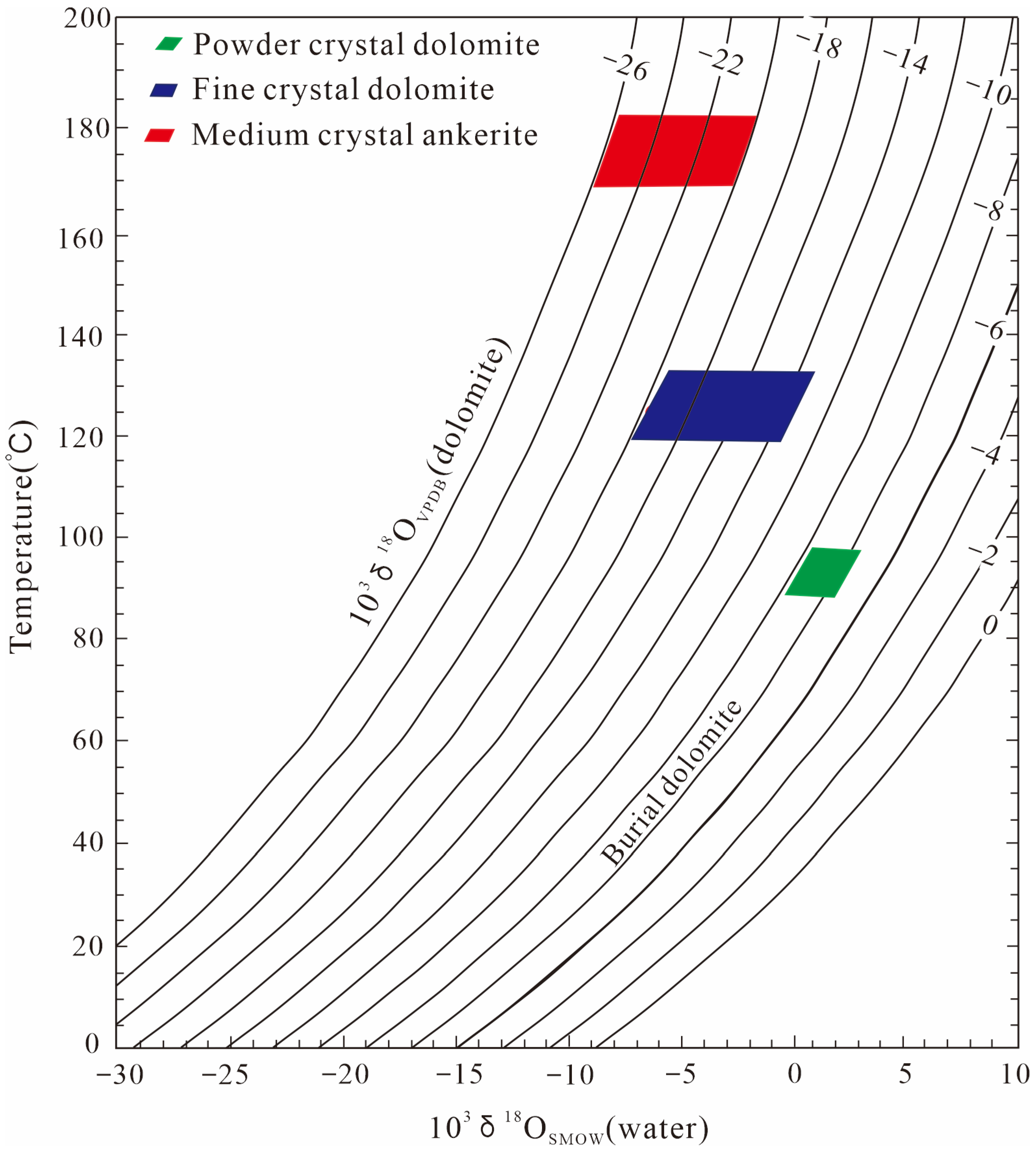
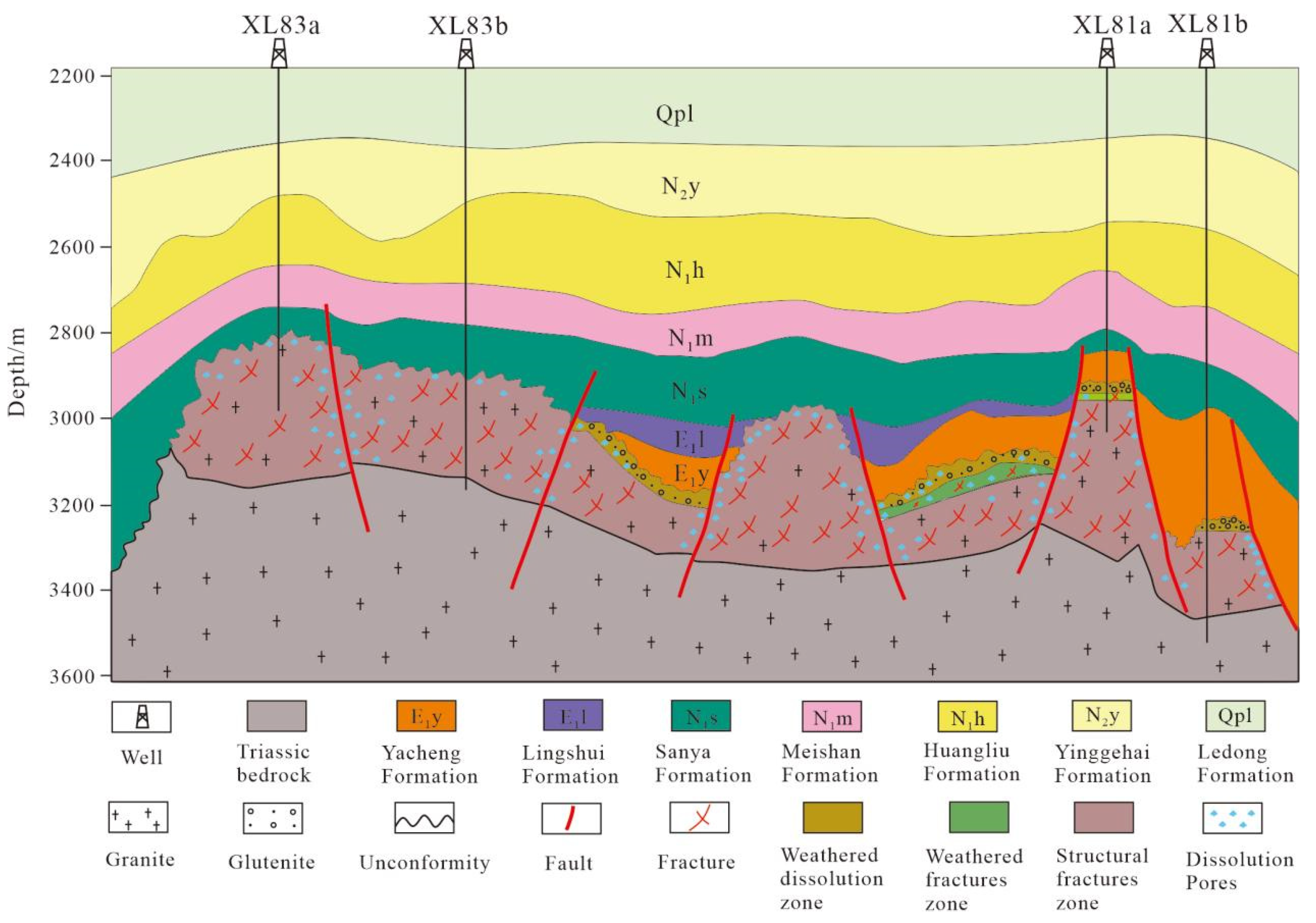
Disclaimer/Publisher’s Note: The statements, opinions and data contained in all publications are solely those of the individual author(s) and contributor(s) and not of MDPI and/or the editor(s). MDPI and/or the editor(s) disclaim responsibility for any injury to people or property resulting from any ideas, methods, instructions or products referred to in the content. |
© 2024 by the authors. Licensee MDPI, Basel, Switzerland. This article is an open access article distributed under the terms and conditions of the Creative Commons Attribution (CC BY) license (https://creativecommons.org/licenses/by/4.0/).
Share and Cite
Duan, W.; Luo, C.-F.; Shi, L.; Chen, J.-D.; Li, C.-F. Formation Mechanism and Petroleum Geological Significance of (Ferro) Dolomite Veins from Fractured Reservoirs in Granite Buried Hills: Insights from Qiongdongnan Basin, South China Sea. J. Mar. Sci. Eng. 2024, 12, 1970. https://doi.org/10.3390/jmse12111970
Duan W, Luo C-F, Shi L, Chen J-D, Li C-F. Formation Mechanism and Petroleum Geological Significance of (Ferro) Dolomite Veins from Fractured Reservoirs in Granite Buried Hills: Insights from Qiongdongnan Basin, South China Sea. Journal of Marine Science and Engineering. 2024; 12(11):1970. https://doi.org/10.3390/jmse12111970
Chicago/Turabian StyleDuan, Wei, Cheng-Fei Luo, Lin Shi, Jin-Ding Chen, and Chun-Feng Li. 2024. "Formation Mechanism and Petroleum Geological Significance of (Ferro) Dolomite Veins from Fractured Reservoirs in Granite Buried Hills: Insights from Qiongdongnan Basin, South China Sea" Journal of Marine Science and Engineering 12, no. 11: 1970. https://doi.org/10.3390/jmse12111970
APA StyleDuan, W., Luo, C.-F., Shi, L., Chen, J.-D., & Li, C.-F. (2024). Formation Mechanism and Petroleum Geological Significance of (Ferro) Dolomite Veins from Fractured Reservoirs in Granite Buried Hills: Insights from Qiongdongnan Basin, South China Sea. Journal of Marine Science and Engineering, 12(11), 1970. https://doi.org/10.3390/jmse12111970






